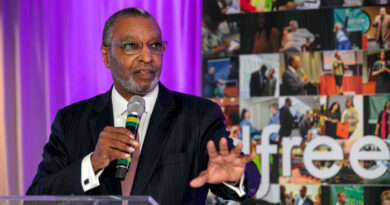Investing in Black-owned banks key to ending racial disparities
At the end of the Civil War and after the abolishment of slavery, African-Americans constituted 14% of the American population, yet owned just 0.5% of the wealth. Today, the numbers are distressingly similar: the percentage of the Black population is about the same, but Black Americans own only 2.6% of the wealth, according to the Brookings Institute.
Over the past year, there has been greater awareness about the increasingly urgent need for greater economic equity. And now is the time to take concrete steps that move us from awareness to action and from discussions to decisions.
The banking system is the financial lifeblood of any community. It ultimately serves as a circulatory system for capitalism. When a community’s banking system is ailing, the community too will suffer.
Nowhere is this clearer than in the dearth of Black-owned banks in Black communities around the U.S. resulting in greater economic inequity in many of these communities. Black-owned, community-focused banks offer much-needed capital and access to financial services for countless people who have been overlooked by major national banks.
I know the positive impact they have firsthand: it was, in fact, a Black-owned bank that took a chance on me as a young real estate investor years ago.
One bank stepped forward
While growing an investment portfolio of commercial real estate in Atlanta in 2012, I sought to close a loan for a 600-unit multifamily portfolio in the Atlanta metropolitan area. While I had a strong group of investors, I was also a Black man in my 20s – an atypical profile for a borrower of a significant commercial real estate portfolio.
I spoke with more than 10 banks and was turned down by all but one despite having a compelling business plan, strong investors behind our partnership, and a strong financial background.
The one bank that agreed to provide me with a loan was Citizens Trust Bank — an institution founded in 1921 by five Black businessmen to promote greater economic prosperity for more individuals.
Now a federally certified community development financial institution (CDFI) and the third-largest Black-owned financial institution in the U.S., the bank has been a key driver of economic growth in communities around the country, stimulating significant investment to communities of color throughout the Southeast.
When my loan was approved, the then-chairman of Citizens Trust called me personally to tell me that he believed in me and knew that everyone needed support to achieve their full potential.
For him, my loan was more than a financial transaction – it was an investment in my future and in the community as a whole. With the support of that bank, I closed on what would be the first transaction of several in the area over the years.
This experience set me on the path I would take to launch Cadre in 2014, a company that owns more than $3 billion of real estate around the country today.
The vote of confidence from the chairman of a Black-owned bank not only positioned me for future success, but also helped reorient Cadre’s mission to help level the playing field in real estate investing so more people could have financial security.

Racial justice, economic justice
In recent months, the conversation about racial justice in America has focused on how we turn our collective outrage at incidents of injustice into sustainable, systemic change.
There’s no question that racial and economic justice are inextricably linked. But when it comes to addressing economic inequality in the U.S., there’s a stark problem: the positive experience I had landing my first big loan is the rare exception.
Black communities have historically been shut out of the financial resources and capital that could allow us to grow businesses, own real estate, invest locally, and truly own our financial futures. Black-focused lenders and banks, CDFIs, and minority depository institutions (MDIs) are undercapitalized.
There are 4,700 banks in the U.S. that hold a combined $20.3 trillion of assets, but as of 2019, only 21 of those banks are Black-owned or led, and those have total assets of just $5 billion.
Further, many large national banking institutions do not have branches in majority-minority neighborhoods, and the banking experience can vary widely in different communities. Even completing regular banking transactions like cashing a check or making a withdrawal can leave Black bank customers open to racial discrimination and even accusations of fraud – so much so that it spawned a new social media hashtag for stories about #BankingWhileBlack.
And now, during the coronavirus pandemic, Black-owned small businesses are shuttering at a much higher rate than white-owned small businesses – an issue compounded by the fact that Black-owned businesses are less likely than white-owned ones to have a traditional banking partner to help steer them through the Paycheck Protection Program loan process.
The racial wealth gap and the broader movement for economic justice are often talked about as if they are problems that are too big or complex to solve.
While I don’t discount the magnitude of the problem, I am a firm believer that “action is the antidote to despair,” and that there are clear steps that can be taken immediately to begin promoting greater economic prosperity for Black communities.
Building relationships
First on that list is forming strong business relationships that generate profit for banks. Financing and loans provide opportunities for banks to earn income and thereby multiply their capital investment in communities.
That’s why Cadre has committed to partnering with several MDIs to participate directly in the financing of future commercial real estate transactions on Cadre’s platform over the next five years. We have intentionally included MDIs in the financing and debt issued in transactions around the country and also committed to partnering with diverse operating partners who are community-based.
And if an even wider range of companies, investors, and organizations make similar commitments to work with Black owned banks, there will be an greater multiplication of wealth and opportunity for communities that have been long deprived of access to capital.
In addition to partnering with MDIs on new business through financing transactions, companies can inject more capital into community banks and financial institutions by building cash deposits with these banks.
Deposits increase the total capital available for lending opportunities such as providing financing for small businesses, home mortgages for families, and other loans for those in Black communities. Cadre has committed to depositing up to 10% of our cash holdings with leading MDIs, including Citizens Trust Bank and Liberty Bank – one of the largest and most successful Black-run banks in the country with headquarters in my home state of Louisiana.
A multidimensional approach that involves both partnering with and supporting Black-owned banks will in turn cause capital flow into underserved communities. More small businesses will take flight, jobs will be created, and lives will be changed.
All in all, there will be a greater chance to build generational wealth in Black communities. I know this because I was a beneficiary of it.
It’s time we collectively dedicate ourselves to actions that provide opportunities for people to lift themselves out of poverty. Investing in communities – specifically in the structural underpinnings that form and support them – is a needed and vital investment in a stronger, more vibrant future for all.
—Ryan Williams is the Co-founder and CEO of Cadre.


